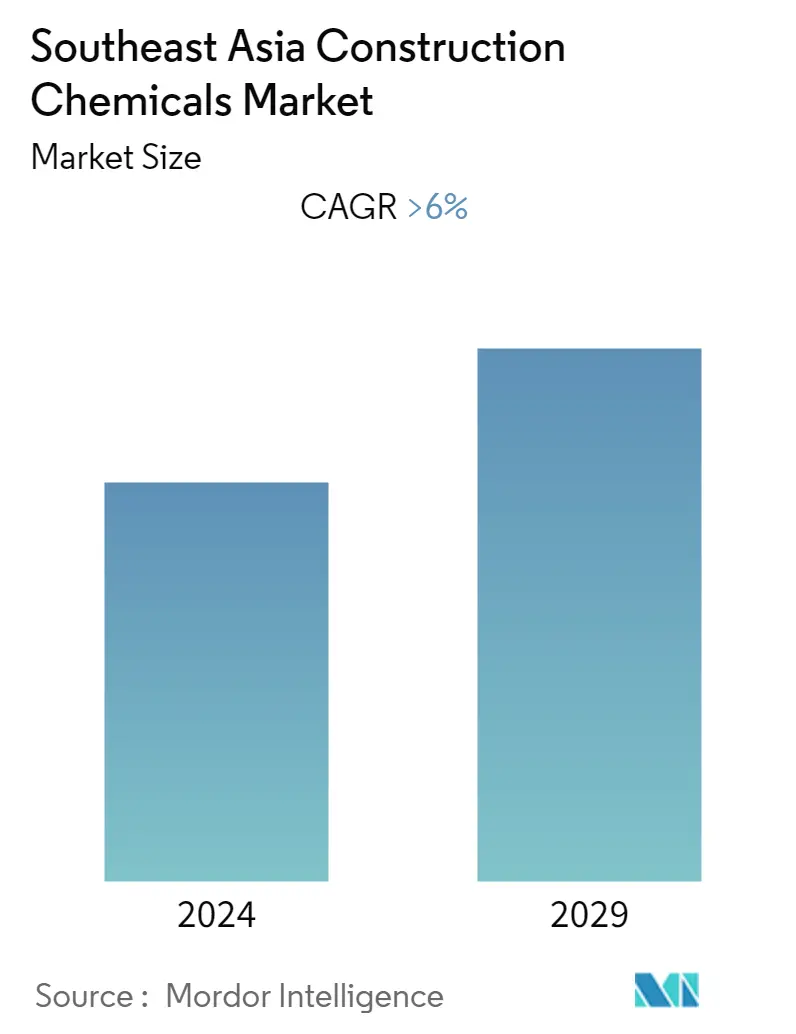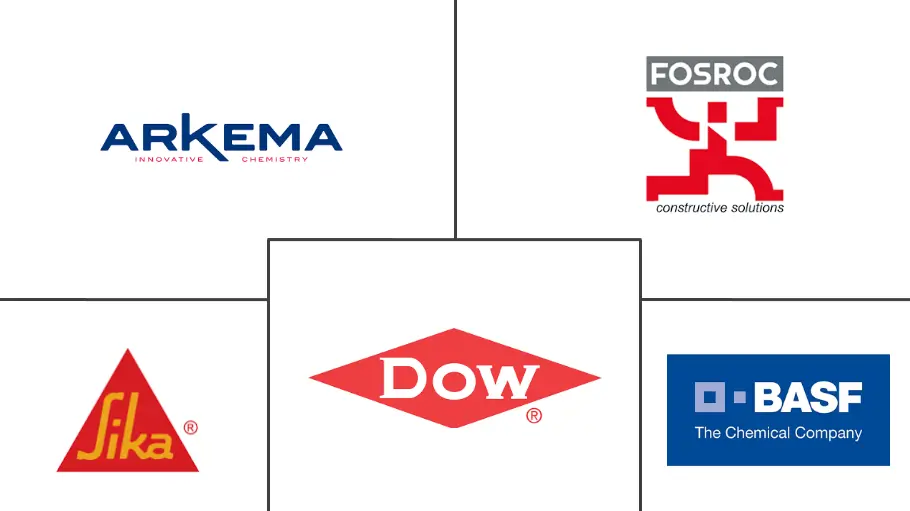Market Size of Southeast Asia Construction Chemicals Industry

| Study Period | 2019 - 2029 |
| Base Year For Estimation | 2023 |
| Forecast Data Period | 2024 - 2029 |
| Historical Data Period | 2019 - 2022 |
| CAGR | 6.00 % |
| Market Concentration | Low |
Major Players
*Disclaimer: Major Players sorted in no particular order |
Southeast Asia Construction Chemicals Market Analysis
The Southeast Asian construction chemicals market is likely to witness a healthy growth, at an estimated CAGR of over 6%, over the forecast period. The construction industry is reflecting huge demand in Southeast Asia, owing to more spending on infrastructure and population growth. The middle-class segment has grown and is expected to grow further during the forecast period. The growth has boosted lifestyle trends and new housing and construction activities in the country.
- Several government regulations are expected to hamper the construction chemicals market in the Southeast Asia region, during the forecast period. The manufacturers of construction chemicals in the region are gradually realizing the importance of globally harmonized system of classification and labeling of chemicals (GHS) regulations.
- By product type, the concrete admixture segment is expected to dominate the market studied, with the highest CAGR of over 7% during the forecast period.
Southeast Asia Construction Chemicals Industry Segmentation
The Southeast Asian construction chemicals market report includes:
| Product Type | |
| Adhesives | |
| Concrete and Cement Admixtures | |
| Flame Retardants | |
| Protective Coatings | |
| Water Proofing Chemicals | |
| Other Construction Chemicals |
| Application | |
| Commercial | |
| Industrial | |
| Infrastructure | |
| Residential |
| Geography | |
| Malaysia | |
| Indonesia | |
| Thailand | |
| Singapore | |
| Philippines | |
| Vietnam | |
| Rest of Southeast Asia |
Southeast Asia Construction Chemicals Market Size Summary
The Southeast Asia construction chemicals market is poised for robust growth, driven by increased infrastructure spending and a burgeoning population. The expansion of the middle-class segment is a significant factor, as it fuels demand for new housing and construction activities. This trend is particularly evident in the residential sector, where there is a growing appetite for luxury housing options such as apartments, penthouses, and villas within gated communities. The concrete admixture segment is anticipated to lead the market, reflecting the highest growth rate. However, the market faces challenges from government regulations, which are prompting manufacturers to align with globally harmonized systems for chemical classification and labeling.
Indonesia stands out as a key player in the region, with substantial growth attributed to rising income levels and urbanization. The Indonesian government's initiative to construct a million housing units underscores the country's commitment to enhancing its infrastructure. This, along with increasing repair and renovation activities, is expected to bolster the demand for construction chemicals. The market is characterized by its fragmented nature, with major companies like Sika AG, BASF SE, Arkema Group, Dow, and Fosroc Inc. playing pivotal roles. These factors collectively contribute to the anticipated growth trajectory of the construction chemicals market in Southeast Asia.
Southeast Asia Construction Chemicals Market Size - Table of Contents
-
1. MARKET DYNAMICS
-
1.1 Drivers
-
1.1.1 Increased Adoption of Innovative Construction Procedures
-
1.1.2 Rising Demand for Water-based Products
-
1.1.3 Other Drivers
-
-
1.2 Restraints
-
1.2.1 Regulations for VOC Emission
-
1.2.2 Impact of COVID-19 Pandemic
-
-
1.3 Industry Value Chain Analysis
-
1.4 Porter's Five Forces Analysis
-
1.4.1 Bargaining Power of Suppliers
-
1.4.2 Bargaining Power of Consumers
-
1.4.3 Threat of New Entrants
-
1.4.4 Threat of Substitute Products and Services
-
1.4.5 Degree of Competition
-
-
-
2. MARKET SEGMENTATION
-
2.1 Product Type
-
2.1.1 Adhesives
-
2.1.2 Concrete and Cement Admixtures
-
2.1.3 Flame Retardants
-
2.1.4 Protective Coatings
-
2.1.5 Water Proofing Chemicals
-
2.1.6 Other Construction Chemicals
-
-
2.2 Application
-
2.2.1 Commercial
-
2.2.2 Industrial
-
2.2.3 Infrastructure
-
2.2.4 Residential
-
-
2.3 Geography
-
2.3.1 Malaysia
-
2.3.2 Indonesia
-
2.3.3 Thailand
-
2.3.4 Singapore
-
2.3.5 Philippines
-
2.3.6 Vietnam
-
2.3.7 Rest of Southeast Asia
-
-
Southeast Asia Construction Chemicals Market Size FAQs
What is the current Southeast Asia Construction Chemicals Market size?
The Southeast Asia Construction Chemicals Market is projected to register a CAGR of greater than 6% during the forecast period (2024-2029)
Who are the key players in Southeast Asia Construction Chemicals Market?
Sika AG, BASF SE, Fosroc Inc., Arkema Group and Dow are the major companies operating in the Southeast Asia Construction Chemicals Market.

